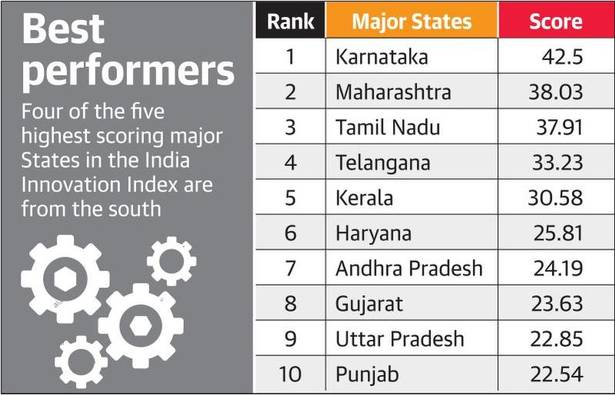Indian Economy
India Innovation Index 2020: NITI Aayog
- 21 Jan 2021
- 6 min read
Why in News
Recently, India Innovation Index Report 2020 was released by NITI Aayog in which Karnataka retained its top position in the major States category.
India Innovation Index
- Institutions Involved:
- NITI (National Institution for Transforming India) Ayog with the Institute for Competitiveness.
- Modelled on GII:
- The index has been developed on the lines of the Global Innovation Index (GII), to ameliorate the innovation ecosystem of Indian states and Union Territories (UTs) and to design policies to drive innovation across regions.
- Approach:
- The index goes beyond traditional approaches by considering the best parameters in measuring innovation such as patents per million of population, publication in scientific journals, percentage of GDP spending on research.
- It also adds parameters that are specific to the Indian economy (eg. Demographic dividend), to give it a more holistic coverage.
- Indicators Used:
- The indicators that the survey uses includes the level and quality of education and parameters such as:
- Number of PhD students and knowledge-intensive employment.
- Enrolment in engineering and technology and number of highly skilled professionals.
- Investment in R&D and number of patents and trademark applications filed.
- Internet subscribers.
- FDI inflows, business environment and safety and legal environment.
- The indicators that the survey uses includes the level and quality of education and parameters such as:
Key Points
- Categories: The Innovation Index is divided into three categories—major states, Union Territories, and hill and North East states.
- Major States:
- Top States: Karnataka topped with a score of 42.5 for the second year running.
- The state’s success has been attributed to a high number of venture capital deals, registered GIs and ICT exports, and high FDI inflow.
- Four southern states – Karnataka, Tamil Nadu, Telangana and Kerala —occupy the top positions on the index, apart from Maharashtra which ranked second.
- Bottom States: Jharkhand, Chhattisgarh and Bihar scored the lowest on the index, which put them at the bottom in the “major States” category.
- Bihar raked last with 14.5 points.
- Top States: Karnataka topped with a score of 42.5 for the second year running.
- Hill and North-East States:
- Himachal Pradesh topped the rankings of hill and North-East states, followed by Uttarakhand, Manipur and Sikkim.
- Union territories/Small States:
- Delhi has scored the highest on the index in the country with a score of 46.6, while Lakshadweep has the lowest score at 11.7.
- Delhi recorded the highest number of trademark and patent applications, along with the establishment of new start-ups and companies in the last financial year.
- Delhi has scored the highest on the index in the country with a score of 46.6, while Lakshadweep has the lowest score at 11.7.
- Challenges:
- Attracting Private Investment in Research: The Indian government is a major spender in R&D, while the investment of the private sector is very low when compared to Israel where private companies account for 70% of private investment in R&D.
- Bridging North-South Divide: In the findings of the report the southern states have fared much better than the North Indian states.
- There is a need to establish to interlink innovative capacities of the states (with differential per capita GDP) to decrease regional disparity in innovation.
- Best practices observed within the States should often be documented and disseminated to encourage peer-to-peer learning.
- Need for micro-analysis of State-level policies: For a country as large as India, the state of innovation needs to be understood at the regional level for effective policy formulation.
- Based on the index each state needs to formulate its own policy, based on its unique resources and strengths and which caters to its specific needs.
- Suggestions:
- Investing More in Research: India needs to increase its spending on R&D which is around 0.6-0.7% of its GDP, way below the expenditure level of countries like Israel (4.3%), South Korea (4.2%), the US (2.8%) and China (2.1%).
- Increased spending on research and development with greater collaboration between the industry and educational institutions may help to enhance innovation capability.
- It could broaden and improve the capability of top rung educational institutions in the country to produce greater innovation outputs.
- Establish a Collaborative Platform: To link all the stakeholders of innovation - innovators, researchers, and investors from the industry, a common platform should be developed.
- It will help to strengthen the industry-academia linkages and will ease the process of technology transfer by providing a platform for innovators to showcase their inventions.
- Investing More in Research: India needs to increase its spending on R&D which is around 0.6-0.7% of its GDP, way below the expenditure level of countries like Israel (4.3%), South Korea (4.2%), the US (2.8%) and China (2.1%).





